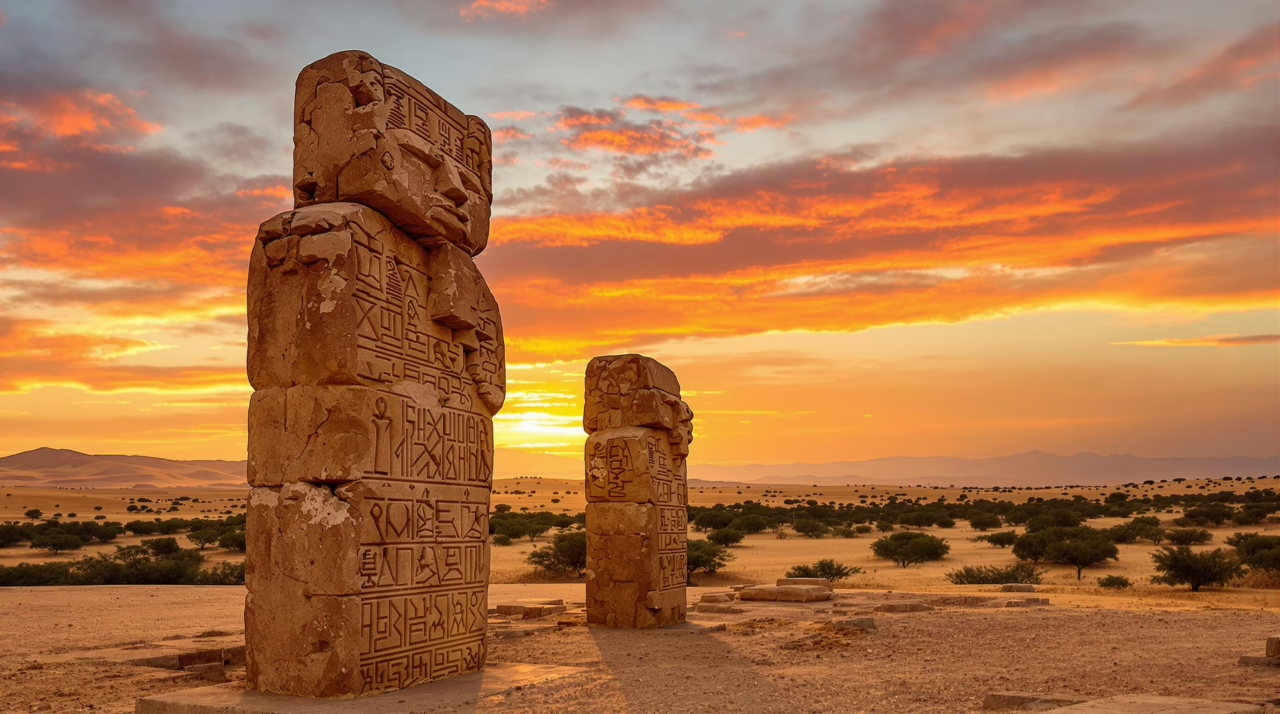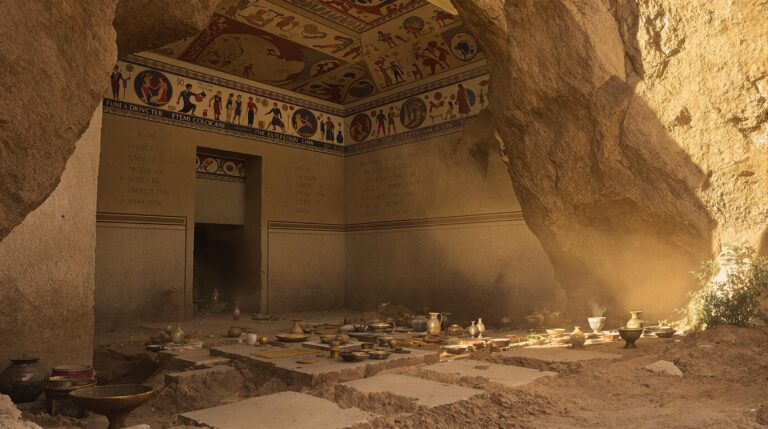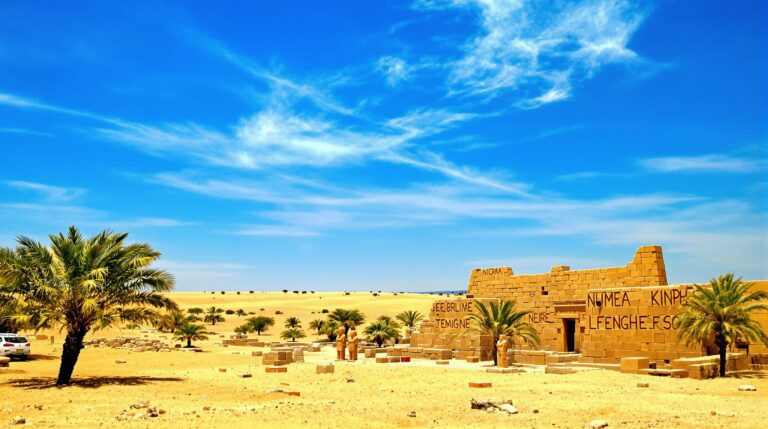Axum in Ancient Africa: Rise and Fall of a Lost Empire

Axum stands as a proof of the complexities of ancient civilizations. Its strategic location fostered extensive trade networks, connecting Africa with distant lands.
The rise of Christianity under King Ezana marked a significant cultural shift. Yet, environmental changes and political strife would eventually undermine this once-thriving empire.
What factors contributed to its decline, and what remnants of Axum’s influence persist in modern Ethiopia?
The answers may reshape our understanding of African history.
Principal Conclusions
Hide- Axum was a powerful ancient empire known for its strategic trade networks connecting Africa, Rome, India, and Arabia.
- The empire thrived economically through the export of gold, ivory, spices, and incense, establishing its global significance.
- Axum transitioned from polytheism to Christianity, becoming one of the first empires to adopt the faith as its state religion.
- Architectural achievements, such as monumental obelisks and royal tombs, showcase Axum's advanced engineering and cultural identity.
- Environmental changes and political fragmentation led to the decline of Axum, marking its transition to the Zagwe Dynasty and cultural resilience.
The Origins and Rise of Axum in Ancient Africa

The origins of Axum are rooted in early settlements that blended diverse cultural influences, setting the stage for a sophisticated society.
This cultural foundation facilitated the establishment of Axumite rule, characterized by ambitious expansion and strategic trade networks.
Analyzing these elements reveals how Axum emerged as a formidable power in the ancient world, shaping the trajectory of regional history.
Early Settlements and Cultural Roots
The early settlements of Axum were notably shaped by the legacies of pre-Aksumite kingdoms, which laid the foundation for its cultural and political development.
Additionally, the strategic positioning along the Red Sea trade routes facilitated Axum’s economic expansion, allowing it to become a pivotal player in regional and international trade networks.
This intersection of local traditions and external influences underscores the complex origins and rise of one of Africa’s most influential empires.
The influence of pre-Aksumite kingdoms in the region
Although often overshadowed by the grandeur of Aksum itself, the pre-Aksumite kingdoms played an essential role in shaping the cultural and political landscape of the region.
These early societies established trade networks, religious practices, and social hierarchies that laid the groundwork for Aksum’s emergence.
Their influence fostered a diverse mosaic of cultural identity, demonstrating the interconnectedness of ancient African civilizations and their enduring legacy.
Role of Red Sea trade routes in Axum’s growth
As Axum began to establish itself as a formidable power in the ancient world, the strategic significance of the Red Sea trade routes became increasingly apparent.
These routes facilitated commerce between Africa, Arabia, and beyond, enabling Axum to flourish economically.
The exchange of goods, culture, and ideas not only strengthened Axum’s influence but also positioned it as a key player in regional and international trade networks.
Foundation and Expansion of Axumite Rule
The rise of Axumite rule was marked by the emergence of its first kings, whose leadership was pivotal in establishing a unified political entity.
This consolidation of power not only solidified their influence but also prompted ambitious territorial expansion, positioning Axum as a formidable force in the region.
Examining these early dynamics reveals the intricate interplay between leadership and statecraft that shaped the trajectory of Axum’s imperial legacy.
The emergence of the first Axumite kings
Emerging from the fertile highlands of present-day Ethiopia and Eritrea, the first Axumite kings laid the foundation of an empire that would become a significant player in regional trade and culture.
Their strategic location and innovative governance fostered economic prosperity, enabling the Axumites to engage with diverse civilizations.
This burgeoning kingdom exemplified the power of leadership in shaping identity and facilitating connections across vast landscapes.
Political consolidation and territorial ambitions
Building upon the foundation laid by the early Axumite kings, the political consolidation of the empire marked a pivotal moment in its rise to power.
Strategic alliances and military conquests expanded Axum’s territory, enhancing its influence across the Red Sea and beyond.
This pursuit of territorial ambitions not only solidified Axum’s dominance but also fostered a rich cultural exchange, ultimately shaping the region’s historical trajectory.
Economic Power and Global Trade
Axum emerged as a pivotal commercial crossroads, linking trade routes between Africa, the Arabian Peninsula, and beyond.
Its innovative use of coinage facilitated transactions and solidified its economic influence, while advanced maritime infrastructure enabled robust trade networks.
In this way, Axum’s economic power not only shaped its own prosperity but also left a lasting imprint on global trade dynamics of the era.
Axum as a Commercial Crossroads
Axum emerged as a pivotal commercial crossroads, facilitating trade connections with powerful entities such as Rome, India, Arabia, and Egypt.
This strategic position allowed Axum to export valuable commodities, including gold, ivory, spices, and incense, which not only enriched its economy but also enhanced its influence across global trade networks.
The empire’s ability to navigate and integrate diverse markets underscores its significance in ancient economic history.
Trade with Rome, India, Arabia, and Egypt
While the rise of Axum as a formidable power in the ancient world is often attributed to its strategic location, its economic prosperity was equally driven by its extensive trade networks.
Engaging with Rome, India, Arabia, and Egypt, Axum became an essential commercial hub. This exchange fostered cultural interactions and economic growth, highlighting Axum’s role in shaping global trade dynamics and emphasizing the interconnectedness of ancient civilizations.
Key exports: gold, ivory, spices, and incense
At the heart of Axum’s economic success lay its rich array of exports, which included gold, ivory, spices, and incense.
These commodities not only fueled local prosperity but also positioned Axum as a crucial link in global trade networks. Their intrinsic value attracted merchants from distant lands, fostering cultural exchanges and cementing Axum’s role as a pivotal commercial crossroads in ancient Africa.
Coinage and Maritime Infrastructure
The introduction of Axumite currency marked a significant advancement in the region’s economic framework, facilitating trade both locally and across vast distances.
Coupled with strategic ports like Adulis, the Axumite economy thrived as a nexus for maritime commerce, linking Africa with the Mediterranean and beyond.
This dual focus on coinage and infrastructure not only enhanced Axum’s wealth but also positioned it as a formidable player in global trade networks.
Introduction of Axumite currency
As Axum emerged as a formidable economic power in the ancient world, its introduction of coinage marked a pivotal moment in facilitating trade and commerce.
This innovative currency system enabled:
- Standardization of trade practices
- Enhanced economic interactions with neighboring regions
- Greater control over resource distribution
These developments not only strengthened Axum’s economy but also positioned it as a key player in global trade networks.
Strategic use of ports like Adulis
Strategic utilization of ports such as Adulis greatly contributed to Axum’s ascendance as a formidable economic power in the ancient world.
These maritime hubs facilitated trade routes connecting Africa, the Mediterranean, and beyond, enabling the exchange of goods and ideas.
The infrastructure fostered a thriving economy, allowing Axum to wield significant influence in global commerce, thereby asserting its prominence in history.
Religion and Spiritual Life
In Axum, religion played a pivotal role in shaping both social and political structures, shifting from early polytheism characterized by diverse sacred practices to the establishment of Christianity as the state religion.
This transformation not only reflected the empire’s evolving identity but also influenced its interactions with neighboring cultures and trade networks.
Examining these shifts offers insight into how spiritual beliefs can both unify and divide a civilization.
Early Polytheism and Sacred Practices
The early polytheism of Axum reflects a diverse array of indigenous beliefs centered around a pantheon of deities that influenced both daily life and governance.
Temple sites and religious artifacts unearthed in the region provide critical insights into the spiritual practices and rituals that defined the empire’s identity.
Understanding these sacred traditions illuminates the complex interplay between religion and culture in one of Africa’s most significant historical empires.
Indigenous beliefs and deities
Numerous indigenous beliefs and deities shaped the spiritual landscape of the Axumite Empire, reflecting a diverse mosaic of early polytheism and sacred practices.
These beliefs often intertwined with daily life, fostering a sense of community and identity.
Key aspects included:
- Reverence for nature and ancestral spirits
- Worship of deities symbolizing fertility and agriculture
- Rituals aimed at ensuring prosperity and divine favor
Temple sites and religious artifacts
Temple sites and religious artifacts serve as essential windows into the spiritual life of the Axumite Empire, revealing a complex interplay between architecture, ritual, and community identity.
These sites, characterized by their monumental obelisks and intricate carvings, illustrate the Axumites’ devotion to a pantheon of deities, while artifacts unearthed within them provide insight into the daily lives and spiritual practices that shaped this remarkable civilization.
Christianity and State Religion
The conversion of King Ezana marked a pivotal moment in Axum’s history, as his embrace of Christianity transformed it into a state religion.
This shift not only solidified the church’s influence over governance but also spurred the construction of churches and the incorporation of Christian symbols into Axumite art.
The interplay between faith and politics in this empire invites deeper exploration of how religion shaped societal values and cultural identity.
Conversion of King Ezana and adoption of Christianity
King Ezana’s conversion to Christianity marked a pivotal moment in the history of the Axumite Empire, signaling not just a personal transformation but a profound shift in the cultural and religious landscape of the region.
This change included:
- The establishment of Christianity as a state religion
- The integration of Christian values into governance
- The promotion of trade and diplomacy with Christian nations
This transformation paved the way for significant societal changes.
Construction of churches and Christian symbols in art
As Christianity took root in the Axumite Empire, the construction of churches and the emergence of Christian symbols in art became essential expressions of the new faith and its integration into daily life.
These architectural marvels and artistic representations reflected not only religious devotion but also a cultural transformation, embodying the aspirations of a society seeking spiritual depth and unity under a divine ethos.
Engineering Feats and Architectural Legacy
The architectural achievements of Axum stand as a demonstration of its advanced engineering capabilities and urban sophistication. Notable among these are the iconic obelisks and royal tombs, which reflect not only the empire’s grandeur but also its intricate understanding of monumental design.
This legacy invites a closer examination of how such structures were integrated into the urban landscape, shaping both the physical and cultural identity of Axum.
The Obelisks and Royal Tombs
The obelisks of Axum stand as monumental symbols of the empire’s power and religious significance, reflecting a complex interplay of cultural identity and spiritual beliefs.
Their construction showcases advanced engineering techniques and the use of local materials, demonstrating the ingenuity of ancient artisans.
Purpose and symbolism of the stelae
While the stelae of Axum stand as monumental representations to the engineering prowess of an ancient civilization, their purpose and symbolism extend far beyond mere architectural achievements.
They serve to:
- Honor deceased rulers and signify their divine connection.
- Mark territorial boundaries, asserting Axum’s power.
- Embody cultural identity, reflecting the sophistication of Axumite society.
These elements collectively illustrate the civilization’s complex social and political landscape.
Construction techniques and material use
Remarkably intricate construction techniques and the strategic use of local materials characterize the architectural legacy of Axum, particularly evident in its iconic obelisks and royal tombs.
The mastery of stone carving and precision engineering allowed for the creation of towering structures, symbolizing power and spirituality.
These feats not only reflect advanced understanding of engineering but also signify a profound connection to the cultural identity of the Axumite civilization.
Urban Planning and Monumental Design
Axum’s urban planning reflects a sophisticated understanding of infrastructure, evidenced by its carefully arranged capital city layout, which facilitated trade and governance.
The monumental design of palaces and the intricate road systems further underscores the Empire’s engineering prowess, showcasing a commitment to both functionality and aesthetics.
Water infrastructure, essential for sustaining life and enhancing urban livability, highlights the advanced technical skills of Axum’s builders and their ability to harmonize natural resources with urban needs.
Layout of the capital city
The layout of Axum, a demonstration to the ingenuity of its engineers and architects, reveals a sophisticated understanding of urban planning that was ahead of its time.
Key elements include:
- An intricate arrangement of monumental obelisks symbolizing power and spirituality.
- Strategically placed marketplaces fostering trade and community interaction.
- A network of pathways facilitating movement and connectivity throughout the city.
This design underscores Axum’s architectural legacy and cultural significance.
Palaces, road systems, and water infrastructure
Building upon the sophisticated urban layout previously discussed, Axum’s architectural achievements extend into its palaces, road systems, and water infrastructure, showcasing an impressive blend of functionality and grandeur.
The lavish palaces reflected the empire’s wealth, while the extensive road systems facilitated trade and communication.
Moreover, advanced water infrastructure demonstrated an understanding of hydrology, enhancing urban life and contributing to Axum’s enduring legacy.
Axum’s Role in Regional and Global Affairs
Axum’s military campaigns substantially expanded its territorial reach, positioning it as a formidable power in the region.
This expansion not only altered the political landscape but also fostered cultural exchanges that influenced neighboring civilizations.
Military Campaigns and Territorial Reach
Axum’s military campaigns extended its influence into Arabia and the Nile Valley, reflecting a strategic ambition that shaped regional dynamics.
These conquests not only showcased Axum’s military prowess but also impacted its relationships with neighboring states, often necessitating defensive strategies.
The empire’s ability to navigate both aggression and diplomacy highlights its complex role in the broader tapestry of ancient global affairs.
Conquests in Arabia and the Nile Valley
Throughout its history, the Kingdom of Axum demonstrated a remarkable capacity for military expansion, especially in the regions of Arabia and the Nile Valley.
This strategic ambition was characterized by:
- Establishing trade routes that facilitated economic dominance.
- Gaining control over crucial resources and territories.
- Influencing local cultures through military and diplomatic means.
These conquests considerably shaped Axum’s role in both regional and global affairs.
Defensive strategies and neighboring relations
The Kingdom of Axum employed a range of defensive strategies that were instrumental in maintaining its territorial integrity and fostering stable relations with neighboring states.
By establishing diplomatic ties and engaging in strategic trade agreements, Axum mitigated potential conflicts.
Its military prowess, coupled with a focus on alliances, allowed Axum to navigate regional dynamics effectively, ensuring both security and prosperity within a complex geopolitical landscape.
Influence on Neighboring Civilizations
The Axumite Empire exerted significant influence on neighboring civilizations, particularly through its cultural exchanges with Nubia and the Arabian Peninsula.
These interactions not only facilitated the flow of goods and ideas but also helped shape a distinct Ethiopian identity that persists in contemporary traditions.
Cultural exchange with Nubia and the Arabian Peninsula
Although often overshadowed by larger empires, Axum played a pivotal role in facilitating cultural exchanges between Nubia and the Arabian Peninsula, greatly influencing regional dynamics.
This interaction led to:
- The sharing of artistic and architectural styles.
- The exchange of agricultural practices and trade goods.
- The spread of religious beliefs and languages.
These exchanges enriched the cultures involved, fostering a sense of interconnectedness in the region.
Legacy in Ethiopian identity and traditions
Axum’s enduring legacy is intricately woven into the fabric of Ethiopian identity and traditions, reflecting a remarkable continuity of cultural heritage.
This ancient empire’s architectural innovations, religious practices, and trade networks have profoundly shaped modern Ethiopian society.
Its influence is evident in the preservation of language, art, and communal values, fostering a sense of pride and belonging that transcends generations.
Decline and Disappearance
The decline of the Axumite Empire can be attributed to a complex interplay of environmental shifts and economic downturns, which undermined its agricultural foundations.
Concurrently, political fragmentation and isolation eroded the central authority, leading to a loss of cohesion among its territories.
Together, these factors precipitated the empire’s gradual disappearance from the historical narrative.
Environmental Shifts and Economic Decline
In examining the decline of the Axumite Empire, one cannot overlook the profound impact of environmental shifts, particularly soil degradation and climate change.
These factors not only compromised agricultural productivity but also diminished trade routes that were once essential to Axum’s economic prosperity.
As global trade dynamics evolved, the empire found itself increasingly isolated, contributing to its eventual disappearance from the historical landscape.
Soil degradation and climate change impacts
Although the grandeur of Axum’s empire once thrived in the fertile highlands of present-day Ethiopia, the relentless forces of soil degradation and climate change ultimately undermined its agricultural foundation.
This decline manifested through:
- Erosion of topsoil, leading to diminished crop yields
- Increased aridity, exacerbating water scarcity
- Shifts in climate patterns, disrupting seasonal farming cycles
These environmental changes precipitated economic instability, eroding the empire’s once-vibrant sustenance.
Reduced trade and changing global routes
As Axum’s agricultural foundation crumbled under the weight of environmental challenges, the empire’s extensive trade networks began to falter.
This decline not only diminished its economic prowess but also shifted global trade routes, redirecting commerce away from Axum.
The resulting isolation highlighted the fragility of interconnected economies, serving as a cautionary tale of how environmental and economic shifts can irrevocably alter a civilization’s fate.
Political Fragmentation and Isolation
The decline of the Axumite Empire can be attributed to a complex interplay of political fragmentation and external pressures from rival states.
As internal challenges mounted, the shift to the Zagwe Dynasty marked a significant change, redefining the region’s power dynamics and leaving a lasting legacy.
This period of isolation not only diminished Axum’s influence but also set the stage for a new era in Ethiopian history.
Rise of rival powers and internal challenges
While the Axumite Empire once thrived as a powerful trading hub, its decline was precipitated by the emergence of rival powers and significant internal challenges.
These factors fragmented its political structure and led to isolation:
- Competition from neighboring kingdoms weakened trade routes.
- Internal strife and leadership disputes eroded unity.
- Economic shifts diminished Axum’s influence in regional commerce.
Together, these elements marked the empire’s gradual downfall.
Transition to the Zagwe Dynasty and post-Axum legacy
Amidst the political fragmentation that marked the decline of the Axumite Empire, the change to the Zagwe Dynasty emerged as a pivotal moment in Ethiopian history.
This alteration allowed for a reconfiguration of power, yet it also highlighted the isolation that followed Axum’s fall.
The Zagwe period illuminated Ethiopia’s cultural resilience, forging a distinct identity amidst the remnants of a once-great empire.
Wrapping Up
The story of Axum is one of grandeur and fragility, where monumental obelisks once towered over thriving trade routes, now silent echoes of a lost empire.
Its rise was marked by economic brilliance and cultural richness, yet the same forces that fueled its ascent—environmental changes and political strife—ultimately precipitated its decline.
As history often reveals, the fate of civilizations can pivot dramatically, leaving us to ponder how greatness can so swiftly fade into obscurity.





